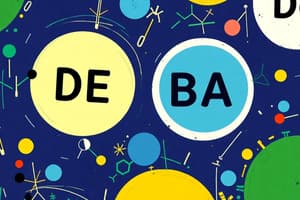Podcast
Questions and Answers
What is the primary reason a substance is classified as Schedule I?
What is the primary reason a substance is classified as Schedule I?
- It has a low potential for abuse.
- It has an accepted medical use in the United States.
- It has a high potential for abuse and no accepted medical use. (correct)
- It can be prescribed under severe restrictions.
Which of the following substances is classified as Schedule I under the CSA?
Which of the following substances is classified as Schedule I under the CSA?
- Methadone
- Morphine
- Codeine
- Marijuana (correct)
What distinguishes Schedule II substances from Schedule I substances?
What distinguishes Schedule II substances from Schedule I substances?
- Schedule II substances are less likely to be abused.
- Schedule II substances have a currently accepted medical use. (correct)
- Schedule II substances are not regulated at all.
- Schedule II substances have no potential for dependence.
What does the term 'accepted medical use' in the context of controlled substances refer to?
What does the term 'accepted medical use' in the context of controlled substances refer to?
Which of the following describes the characteristics of a Schedule II controlled substance?
Which of the following describes the characteristics of a Schedule II controlled substance?
Which of the following substances is a Schedule II narcotic?
Which of the following substances is a Schedule II narcotic?
What is a key difference between the scheduling of controlled substances and their potential for abuse?
What is a key difference between the scheduling of controlled substances and their potential for abuse?
Why might a substance in Schedule I not be prescribed or dispensed?
Why might a substance in Schedule I not be prescribed or dispensed?
Which combination of substances is classified as Schedule II?
Which combination of substances is classified as Schedule II?
What defines a Schedule III controlled substance?
What defines a Schedule III controlled substance?
Which of the following is considered a Schedule IV substance?
Which of the following is considered a Schedule IV substance?
Which of the following drugs is an example of a Schedule V substance?
Which of the following drugs is an example of a Schedule V substance?
What do Scheduled Listed Chemical Products (SLCP) typically contain?
What do Scheduled Listed Chemical Products (SLCP) typically contain?
Which substance is classified under Schedule II narcotics?
Which substance is classified under Schedule II narcotics?
Which of the following is NOT a characteristic of Schedule IV substances?
Which of the following is NOT a characteristic of Schedule IV substances?
What is a key distinguishing feature of Schedule III non-narcotics?
What is a key distinguishing feature of Schedule III non-narcotics?
Which combination describes a Schedule II stimulant?
Which combination describes a Schedule II stimulant?
Which of the following is an accepted use of controlled substances?
Which of the following is an accepted use of controlled substances?
Flashcards are hidden until you start studying
Study Notes
Schedules of Controlled Substances
- Controlled substances are categorized into five schedules by the CSA based on accepted medical use and abuse potential.
- Schedule I substances have no accepted medical use, high abuse potential, and lack of safety for medical supervision.
- Schedule II substances have high abuse potential but are accepted for medical use with severe restrictions, potentially leading to severe dependence.
- Schedules III to V include substances with progressively lower abuse potential and more recognized medical uses.
Schedule I Controlled Substances
- Examples include heroin, LSD, marijuana (cannabis), peyote, methaqualone, and MDMA.
- These substances cannot be prescribed or dispensed for medical purposes.
Schedule II Controlled Substances
- Includes narcotics such as morphine, codeine, opium, hydrocodone (found in products like Vicodin and Lortab), hydromorphone, methadone, meperidine, oxycodone, and fentanyl.
- Stimulants include amphetamine (Adderall), methamphetamine, methylphenidate (Ritalin), and lisdexamfetamine (Vyvanse).
- Other substances: cocaine, amobarbital, and glutethimide.
Schedule III Controlled Substances
- Lower abuse potential than schedules I and II, with accepted medical uses.
- Examples include morphine combo products, codeine combination products (e.g., Tylenol with codeine), buprenorphine products, benzphetamine, phendimetrazine, ketamine, and anabolic steroids like oxandrolone.
Schedule IV Controlled Substances
- Substances have low potential for abuse, accepted medical use, and limited dependence relative to schedule III.
- Examples: Tramadol, alprazolam (Xanax), clonazepam (Klonopin), diazepam (Valium), lorazepam (Ativan), midazolam (Versed), and temazepam (Restoril).
Schedule V Controlled Substances
- Possess the lowest abuse potential and accepted medical uses, often used for antitussive and analgesic purposes.
- Examples include cough preparations like Robitussin AC with not more than 200 mg of codeine per 100 mL or grams.
Scheduled Listed Chemical Products (SLCP)
- Defined as products containing ephedrine, pseudoephedrine, or phenylpropanolamine, sold as non-prescription drugs under the Federal Food, Drug, and Cosmetic Act.
Studying That Suits You
Use AI to generate personalized quizzes and flashcards to suit your learning preferences.




